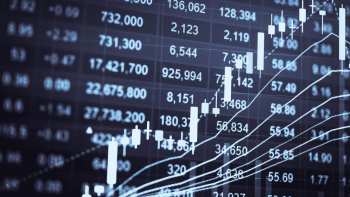German Electricity Prices on the EPEX Spot Exchange in 2020
- German electricity price level drops significantly – How did Covid-19 affect electricity prices in 2020?
- 298 hours with negative prices on the day-ahead market – Will negative electricity prices become more frequent in the future?
- Price spreads increase slightly – What does this mean for the marketing of flexibilities?
German electricity price level drops significantly – How did Covid-19 affect electricity prices in 2020?
In 2020, for the second year in a row, the price level on the German power exchange fell significantly compared with the previous year. The Phelix Day Base (baseload; arithmetic mean of the prices of all hours of a day) traded on EPEX Spot fell to an annual mean of 30.5 €/MWh, down almost 20% year-on-year. The mean prices in the intraday auction as well as in continuous intraday trading also showed a similar decline. However, the significantly higher prices in continuous intraday trading compared to the day-ahead market and intraday auction (31.5 €/MWh versus 30.5 €/MWh in the base product) are striking in 2020. While the traded energy volume on the day-ahead market thereby fell to the lowest value since 2010, the traded volumes in the intraday auction (+10% compared to the previous year) and especially in the quarter-hourly continuous intraday trading (+36% compared to the previous year) continued to increase. Due to the Covid 19 pandemic, there was greater uncertainty in electricity demand, which, combined with higher feed-ins of volatile renewable energy (RE), led to increased volumes in short-term intraday trading.
Analogous to the price level of the baseload, the prices of the peak load (peak load; average price on weekdays Monday through Friday from 8 a.m. – 8 p.m.) and off-peak hours (offpeak load; the average price of all hours that are not in peak) have also declined. For this purpose, Table 1 presents an overview of the mean base, peak, and off-peak prices of the day-ahead market, intraday auction, and quarter-hourly continuous intraday trading (arithmetic mean of all mean, quarter-hourly prices) for the years 2017 to 2020.
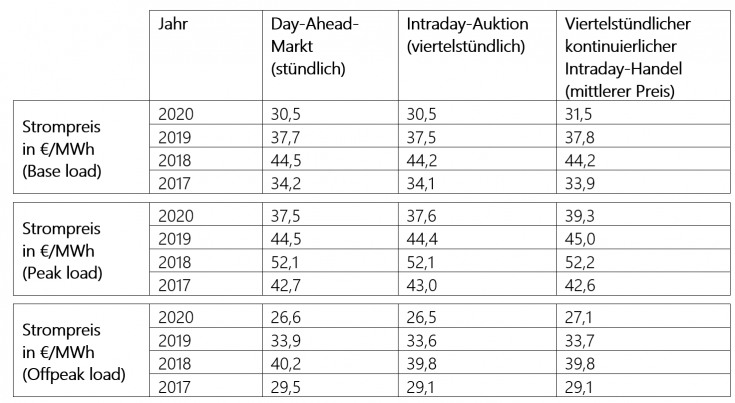
To more accurately identify the impact of the Covid-19 pandemic on electricity prices, Figure 1 depicts the electricity price characteristics of the day-ahead market, or quarter-hourly more continuous intraday trading, over 2020. The lockdown from March to May caused a reduction in electricity demand (for example, industrial plants were temporarily closed) and, combined with favorable fuel prices, resulted in very low and often negative electricity prices (shown in light blue). The Corona measures in Germany, which have been stepped up again since the fall, again had no significant impact on electricity prices on the exchange. At the end of the year, the price-increasing effects of higher fuel prices and, above all, high CO2 certificate prices (up to 33.3 €/tCO2 [2]) clearly predominated here. In addition to the influence of Covid-19, the figure still shows a seasonal characteristic depending on sunset, a weekly characteristic with lower electricity prices on weekends, and a daily characteristic due to typical electricity demand and typical PV feed-in.
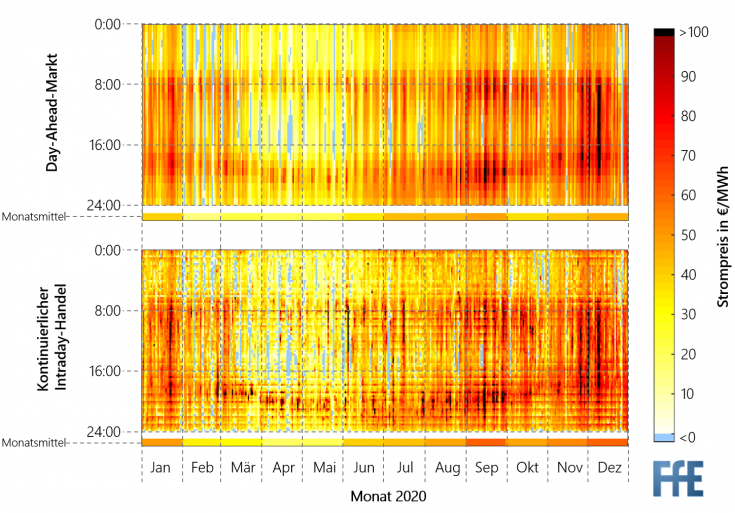
298 hours with negative prices on the day-ahead market – Will negative electricity prices become more frequent in the future?
The development of the number of hours (day-ahead market) or quarter hours (intraday trading) with negative electricity prices over the last four years is summarized in table 2. There was a significant increase in the number of times with negative prices on the German spot markets in 2020. There was an increase of a good 40% year-on-year to 298 hours on the day-ahead market with negative prices. 192 of the 298 hours fell within the „6-hour rule“so that no market premium was paid at these times for larger EEG-subsidized plants in particular. Furthermore, table 2 lists the average price and the average volume of the hours with negative prices for the day-ahead market so that the amount paid for the electricity generated in these hours (negative electricity value) can be calculated. It is noteworthy here that despite a sharp increase in the number of hours with negative prices, this negative electricity value in 2020 of just under -150 million euros has only fallen slightly, or not at all, compared to 2017 and 2019. This is due to both the lower volume traded at these hours and the higher average price that occurred in these hours. Approximately 50% of German load is procured via EPEX Spot [3], so assuming trades away from the exchange have a similar price, doubling the negative power value.
Continuous intraday trading showed 1783 quarter hours of negative prices, a 56% increase in time points. In the intraday auction, the number of quarter hours with negative prices increased by 86% to 2041 quarter hours. The volume is significantly lower in the quarter-hourly intraday markets, so the negative power value is also comparatively less relevant here.
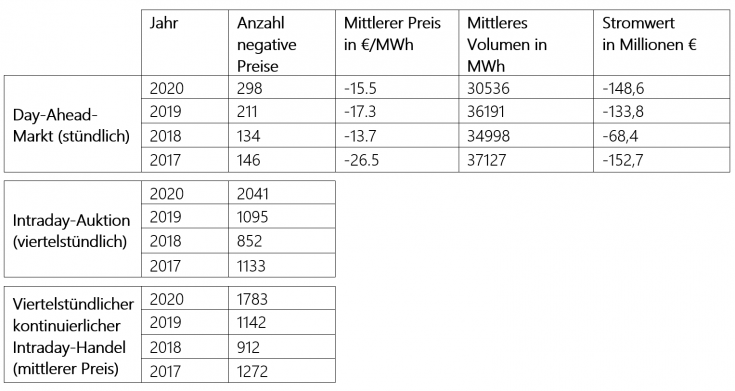
Significantly more frequent negative day-ahead and intraday prices over the past two years raise the question of whether we will see more and more negative prices in the coming years as volatile, renewable energy capacities increase. The main reasons why negative prices occur at all are as follows:
- The EEG subsidy through fixed feed-in tariffs or market premiums means that renewables remain in the market even when electricity prices are negative.
- Start-up and shut-down costs of conventional power plants lead to the acceptance of negative prices. Therefore, large, inert power plants, in particular, continue to produce at partial load (pay for their generated electricity) even when prices are negative to avoid start-up and shut-down.
- Power plants with combined heat and power (CHP) get paid for the heat they generate as well as the electricity, so very low to negative marginal costs can occur in the electricity market.
On the other hand, there is the question of how the structure of the energy system in Germany and regulation will develop in the coming years:
- An increasing number of RE plants are dropping out of the 20-year fixed EEG subsidy. As a result, these plants will move into direct marketing, where they will have to pay when electricity prices are negative and will thus prefer not to feed into the grid.
- The “6-hour rule” eliminates the market premium for six consecutive hours of negative prices, especially for larger plants, so that they have an incentive to leave the market. The “6-hour rule” regulated in § 51 EEG will be tightened in the EEG 2021, in that this will in the future already apply at four instead of six consecutive hours with negative prices [4], [5].
- Due to the German and European climate targets, there are increasing closures of conventional nuclear and coal-fired power plants (in Germany, nuclear energy phase-out by 2023 and coal phase-out by 2038). As a result, many large, inert power plant units are dropping out of the system, making it more dynamic.
- To make CHP more flexible, innovative CHP plants with electric heat providers are subsidized so that these CHP plants do not operate when electricity prices are negative.
Consequently, there are many reasons to counter the trend in recent years of more negative electricity prices. In the future (time horizon from 2025), it can be assumed that negative prices will be seen less often and, above all, less pronounced, and that market prices will settle more often at the real, short-term marginal costs of renewable energies (i.e., at least 0 €/MWh).
Price spreads increase slightly – What does this mean for the marketing of flexibilities?
In addition to the price level, the price spreads are particularly decisive for using flexibilities on the electricity markets. For this purpose, Figure 2 analyzes the maximum daily spreads of day-ahead trading (DA market) as well as the maximum intra-hourly spreads of the intraday auction and quarter-hourly continuous intraday trading for the years 2018 to 2020.
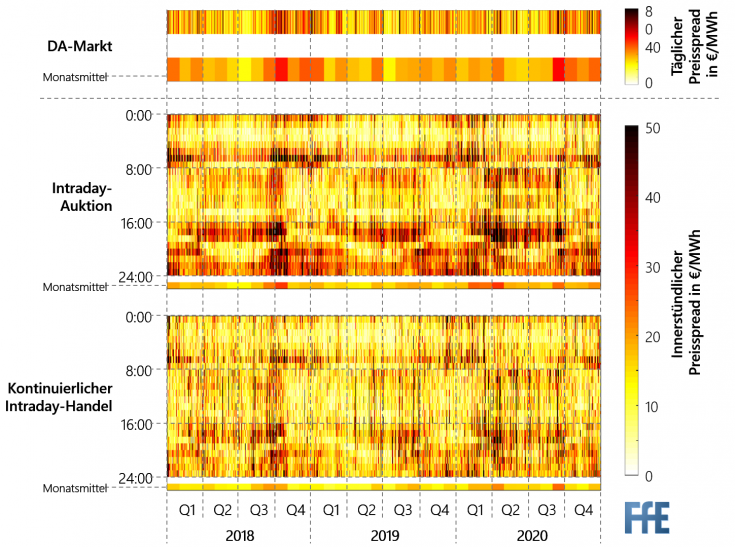
The average daily maximum price spreads in day-ahead trading and the average intra-hourly maximum price spreads in intraday trading increased slightly in 2020 compared to previous years. In addition to the maximum daily and hourly price spreads from 2018 to 2020, Table 3 also shows the daily and hourly standard deviation of electricity prices in the day-ahead market and intraday trading. Daily and hourly standard deviation also increased in 2020 compared with the previous year in all markets, with price volatility increasing in intraday markets in particular.
In a recent publication, we show the revenue potential of bidirectional vehicles as exemplary flexibility for 2019 [3]. When marketed in combined day-ahead and intraday markets, the potential revenues were 620-720 euros per year for an exemplary electric vehicle (100 kWh, 11 kW charge/discharge capacity). Due to the slightly increased price spreads, the potential revenues in 2020 can be increased by more than 10% to 680-810 euros per year. With potentially higher price volatility in the future, the revenue potential of flexibilities on the spot markets will also increase.

For a more in-depth analysis of European electricity prices in 2020, click here.
Further information:
- European day-ahead electricity prices in 2020
- Die deutschen Strompreise an der Börse EPEX Spot in 2019 – Analyse des Preisniveaus und der Preisschwankungen (Preisspreads)
- Energiemärkte in Turbulenzen – Coronavirus (SARS-CoV-2) und Öl-Preiskampf verursachen starken Preisverfall an den Strom- und Brennstoffbörsen
- Analyse von einem Jahr Strompreiszonentrennung zwischen Deutschland und Österreich – Was ist passiert? Wer profitiert?
Sources:
[1] EPEX SPOT. 2020. “Market data”, https://www.epexspot.com/en/market-data
[2] EEX. 2020. “Umweltprodukte – Spotmarkt”, https://www.eex.com/de/marktdaten/umweltprodukte/spotmarkt
[3] Kern, Timo; Dossow, Patrick; von Roon, Serafin. 2020. “Integrating Bidirectionally Chargeable Electric Vehicles into the Electricity Markets” Energies 13, no. 21: 5812, https://www.mdpi.com/1996-1073/13/21/5812/htm
[4] Bundesregierung. 2020. „Entwurf eines Gesetzes zur Änderung des Erneuerbare-Energien-Gesetzes und weiterer energierechtlicher Vorschriften“, https://www.bmwi.de/Redaktion/DE/Downloads/G/gesetzentwurf-aenderung-erneuerbare-energien-gesetzes-und-weiterer-energierechtlicher-vorschriften.pdf?__blob=publicationFile
[5] Bericht des Abgeordneten Lorenz Gösta Beutin. 2020. „Bericht des Ausschusses für Wirtschaft und Energie (9. Ausschuss)“, https://dip21.bundestag.de/dip21/btd/19/253/1925326.pdf


